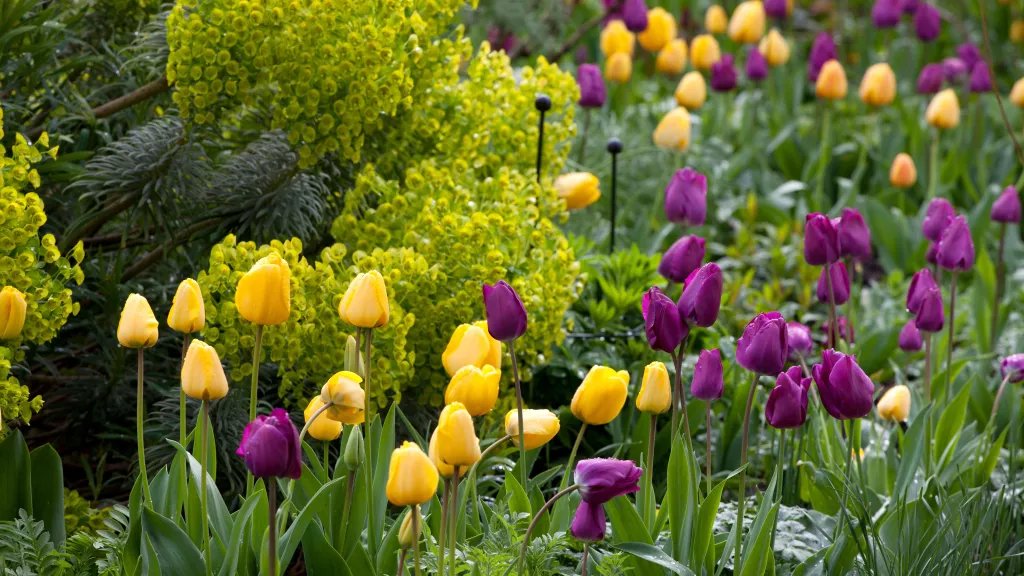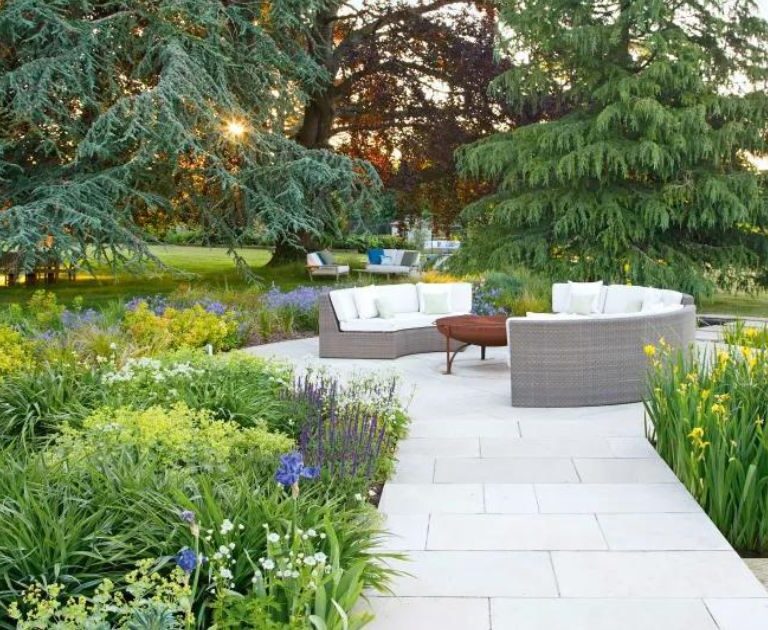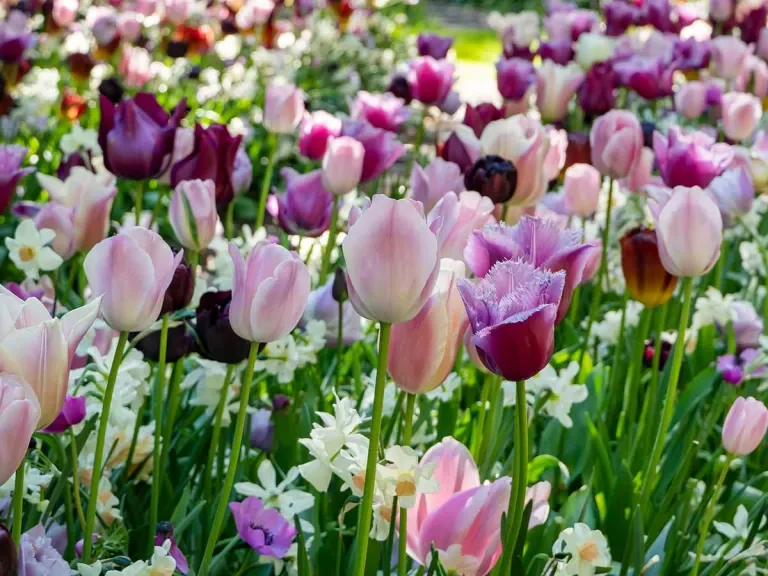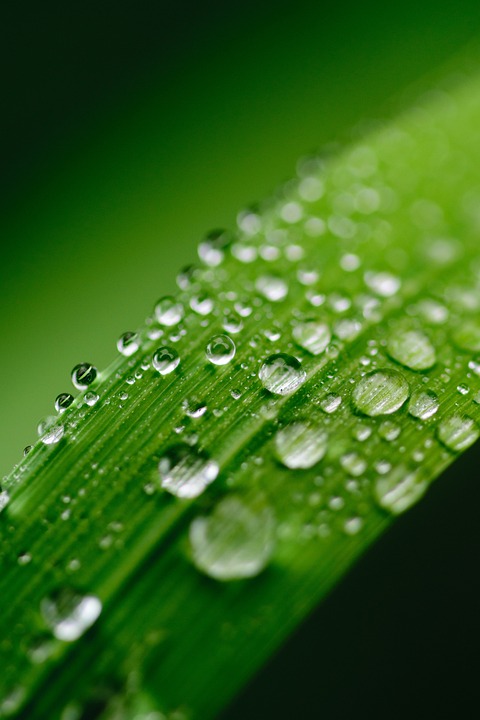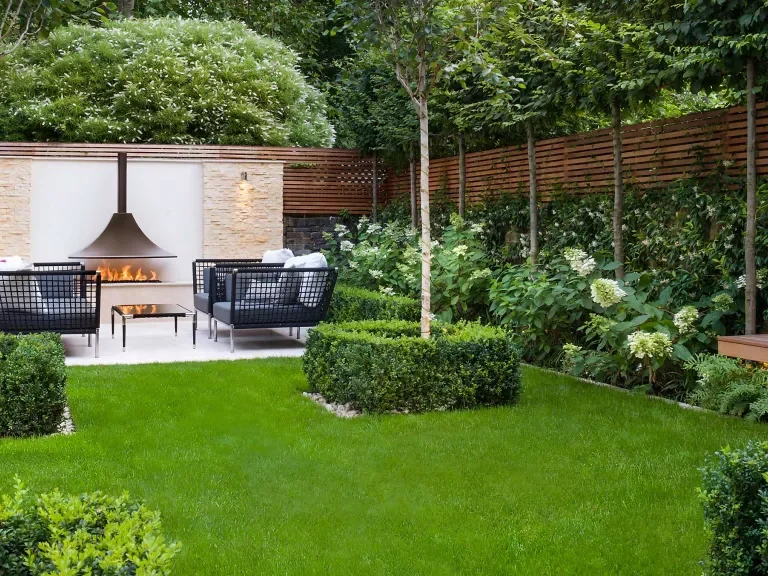How to plant tulip bulbs – for a dazzling display of spring flowers
If you want a showy spring garden, it’s worth learning how to plant tulip bulbs. This traditional flower symbolises rebirth and is much admired for its beautiful, showy blooms worldwide.
Like other flowering bulbs, tulips need to be planted in the fall or when the outside/soil temps are at 60oF or colder so their roots can develop over the winter in preparation for the spring.
One of the best spring bulbs, tulip bulbs can be planted in flower beds, containers, and even hanging baskets for an abundance of spring splendour.
There are almost 8,000 different types of tulips categorized into 15 other families. Tulips appear in nearly every rainbow colour except blue and genuine black.
There is a wide range of flower types, sizes, and heights available; some flower earlier than others, so timing is essential.
Sarah Raven, a gardening expert and author, says tulips are her favourite spring bulb because of their bold colours, unique shapes, and positive energy in flower beds and planters.
Anne Olivieri, whose gardens at Morton Hall in the United Kingdom host the annual Tulip Festival, says, “They have not lost their influence on people.” Olivieri’s 6,000-strong tulip display is a significant draw for the festival. You can grow tulips everywhere, from containers to open fields, in the city or the country, but the key is density.
Although the small species of tulips will multiply yearly, it’s best to plant new tulips every fall in the hands of someone who has read our advice on how to plant tulip bulbs, whether in a container or on the ground; these beautiful flowers will flourish.
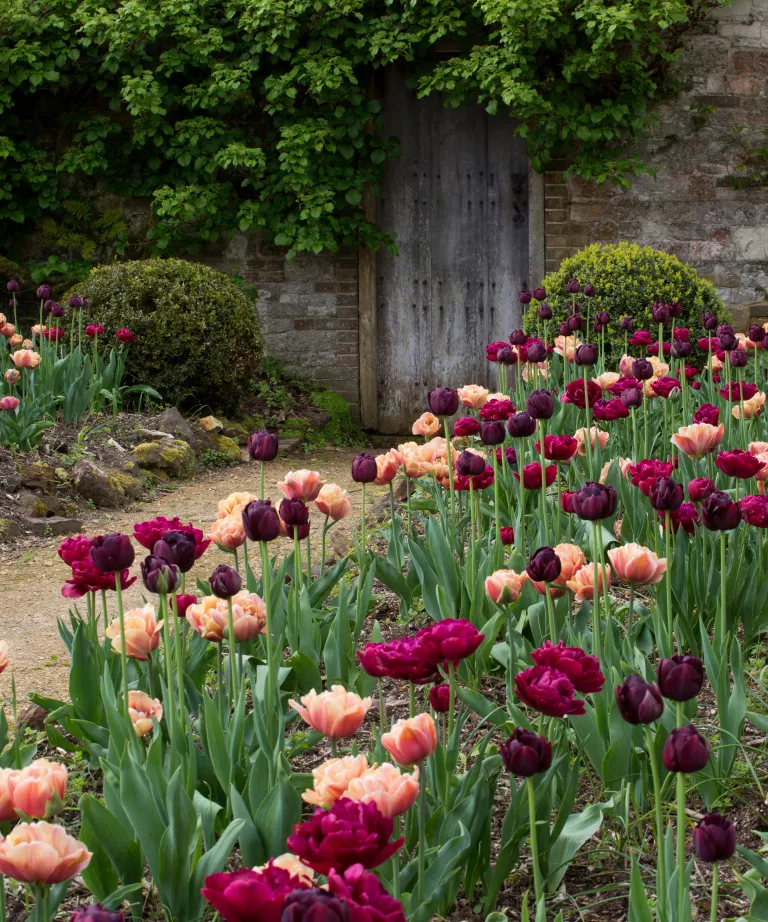
HOW TO PLANT TULIP BULBS IN THE GROUND
When learning how to plant tulip bulbs, the first thing to remember is that they prefer neutral to alkaline soil that drains well. Compost or leaf mould are great ways to boost the quality of the earth in your borders; if your soil is acidic, you’ll want to supplement it with some lime for optimal growth. Learn the basics of soil pH testing with our comprehensive guide.
Purchase tulip bulbs only from trusted bulbs, and examine them well before planting. You want to find white or beige bulbs that are firm and free of any signs of damage, such as new shoots, wounds, or mould.
Tulip grower Mark Eves of Belmont Nurseries, who supplies through Taylors Bulbs, says, “When making your selection, keep in mind that it is not all about the size, as far as bulbs go; a nice clean bulb which is good and heavy for its size carries far more energy to make flowers than a large, lightweight one.”
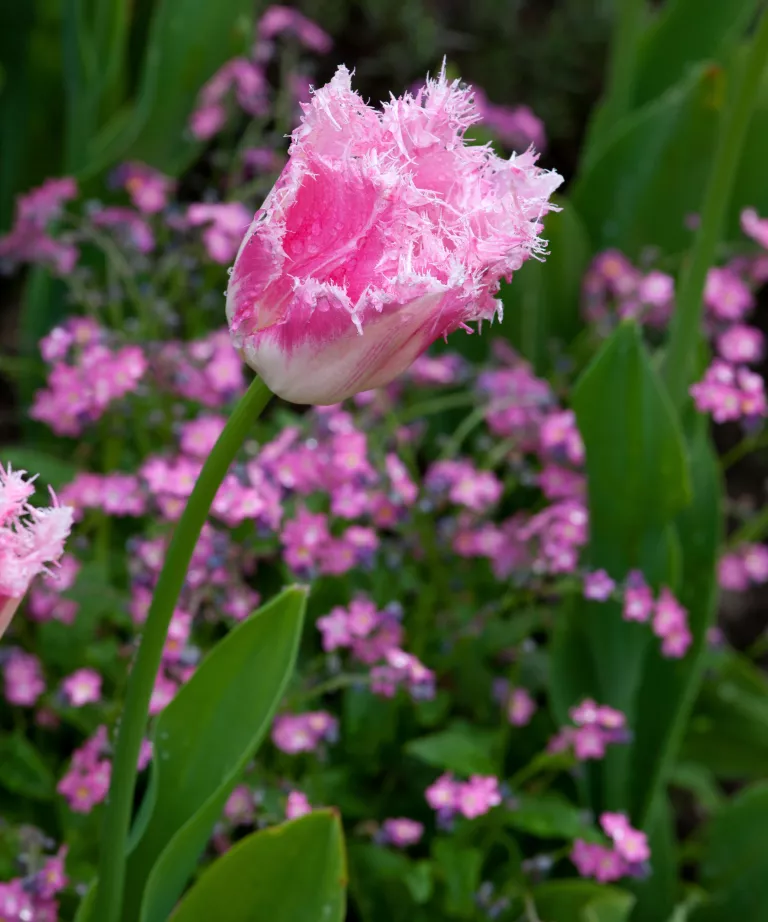
- Plant tulip bulbs are about three times as deep as their heights. They might not do well in extremely cold or hot weather if they aren’t set in deep enough. The ideal drilling depth for tulip bulbs is between 5 and 7 inches. In freezing climates, you may need to plant them more profound.
- A conventional bulb planter can be used to facilitate the planting of tulips. A bulb planter, which looks like a vast apple corer and, when pressed into the ground, chops out a core of dirt, is an excellent tool for planting through herbaceous plants and shrubs or grass, as recommended by Sarah Raven.
- Carefully insert each tulip bulb into its respective hole with the pointed end pointing above and the blunt end facing downward.
- “Pop a tiny bit of spent compost or grit into the bottom of the hole, add the tulip bulb, then backfill with grit and compost just like you would in the trench,” Sarah instructs.
- Plant tulips at a distance of about 4 to 5in, or twice their width, apart to prevent them from squeezing one other out of the soil.
- Replant the bulbs by covering them with soil and packing it firmly back into the hole.
- Don’t just plant a bulb and leave it without water.
HOW TO PLANT TULIP BULBS IN POTS
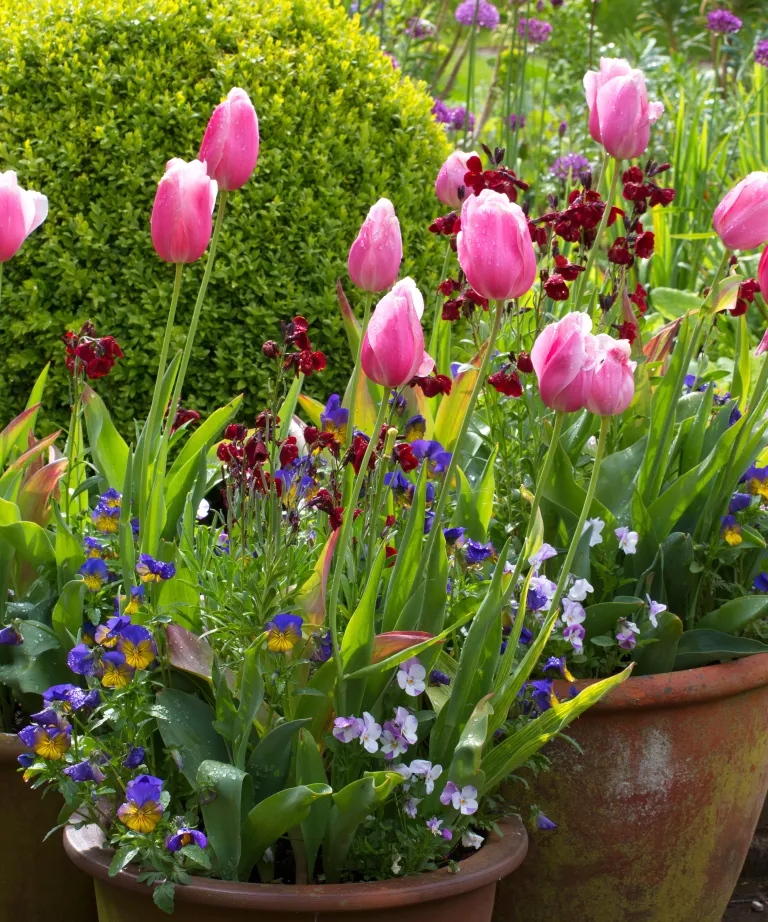
If you want to plant tulips but don’t have the right circumstances in your borders, or if you’re going to have them close to your soil, you may utilize your container gardening ideas to make the appropriate setting for them.
Bulb lasagna, in which layers of bulbs that flower at different times can produce a longer show in spring, is another great reason to plant tulips in containers.
According to gardening guru Monty Don’s blog, the best way to plant tulips is to “make a tulip lasagne,” in which an early variety like “Orange Emperor” is planted at the bottom and will flower first. A midseason variety like “Negrita” is planted above it, and finally, a late-blooming variety like “Queen of Night” is planted on top.
The soil over the bulbs and put another layer of bulbs on top before filling in the hole if you’re low on room. Sarah Raven suggests you overplant the tulips because there is still enough soil above the bulbs to prevent any harm.
Another suggestion from gardening expert Leigh Clapp is to “pot up some containers that you can just put into any holes in your borders, plunged into the soil or sitting on the soil with the pot covered by foliage from adjacent shrubs.”
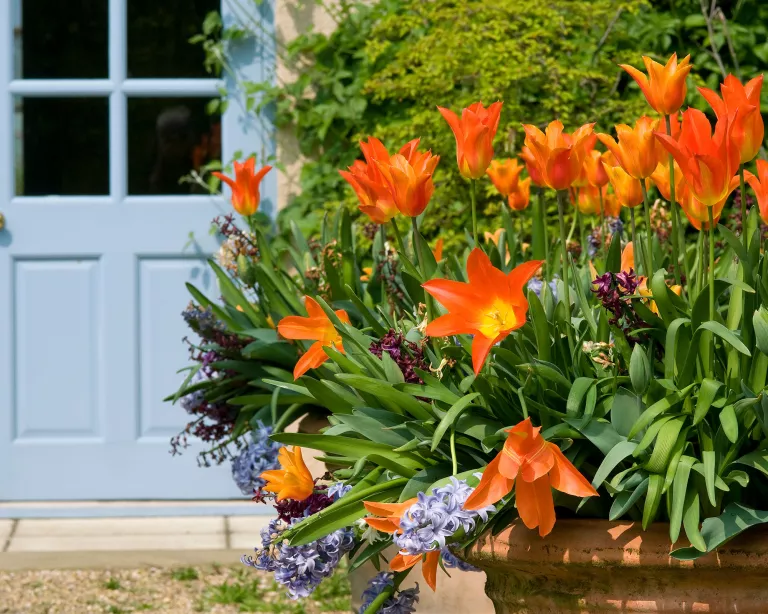
Greg Ovenden, head gardener at Pashley Manor, where a world-famous annual tulip festival is held each spring, explains that they “do lasagne planting in the containers,” beginning the display with species tulips that last well and are not as affected by rain and wind, and mixing in different bulbs, including dwarf narcissi, Muscari, and crocuses, as well as bedding plants like viola,
“If the tulips are showing signs of flowering too soon, we move the containers into the shadow until there is a cold period at the beginning of April,” Greg explains.
Here are the procedures you need to take to plant tulip bulbs in containers successfully:
- Be sure to choose a tall vase to accommodate the tulips.
- Put some loose soil in a container with good drainage; if the soil is too compact, you can break it up with organic material. The soil around bulbs must be kept moist but not soggy.
- Carefully insert each tulip bulb into its respective hole with the pointed end pointing above and the blunt end facing downward.
- There will be less space between bulbs than in borders; make sure they don’t touch.
- Water the plants once after they’ve been planted.
- Be sure to store the pots somewhere cool and dry until spring.
Consider relocating your potted tulip bulbs to a cool place (no warmer than 60oF), well-ventilated, and dark if you reside in hardiness zone 3-7 or if you anticipate exceptionally cold or warm weather.
WHEN TO PLANT TULIPS

To ensure spring blooming, tulips must be planted in the fall. Depending on latitude, this may be October or even November. However, it would be September or October in the north and other cooler regions.
Outside those times, you can still plant tulip bulbs, but you should wait until the soil temperature is 60 degrees Fahrenheit or lower.
Diseases such as viruses and fungi that live in the soil and could infect the bulbs are killed off by the freezing temperatures. Sarah Raven states, “Planting later is a classic way of disease protection.”
WHERE TO PLANT TULIP BULBS
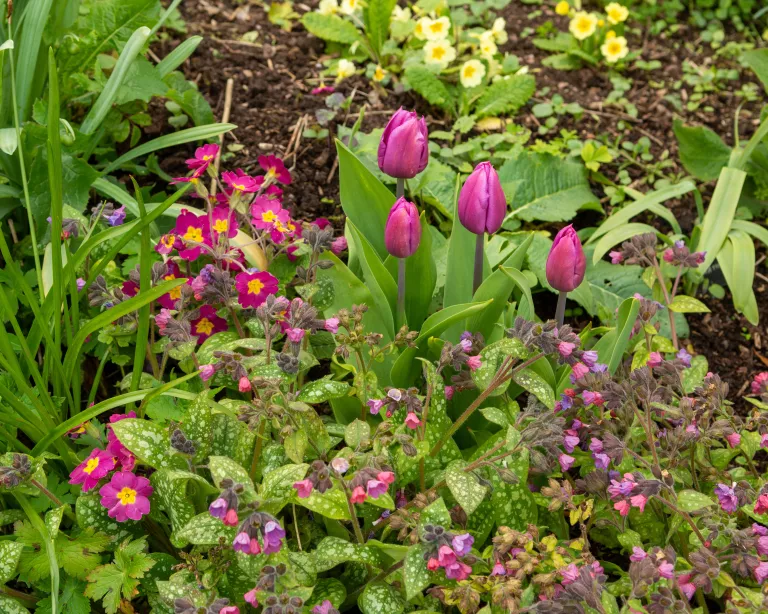
Although most tulip bulbs are acceptable in either full sun or partial shade, it is essential to double-check the sun requirements of your specific variety before making a purchase. In low light, “the whites and pastel colours work exceptionally nicely,” as Sarah Raven puts it.
Some tulips do well in moist soil and shade (like under a tree), but the majority do best on well-drained compost in full sun.
Tulips, just like us, despite the rain and the chill. ‘A tiny sun trap in a corner will have them blossoming before everyone else,’ says Mark Eves of Belmont Nurseries. ‘Soil type doesn’t matter as long as it’s not too thick, but they won’t live if wet logged.
Tulip bulbs will perish if left in moist soil for too long. This could include adding organic matter to the soil, and if you’re growing tulips in bulbs, ensure they have adequate drainage.
“Gardening on heavy soil requires a 2-inch layer of cleaned sharp sand, horticultural grit, or spent compost,” says the article. Sarah Raven recommends mixing a handful of the bone meal with the soil/grit at the bottom of the hole or trench to promote the production of next year’s flowers.
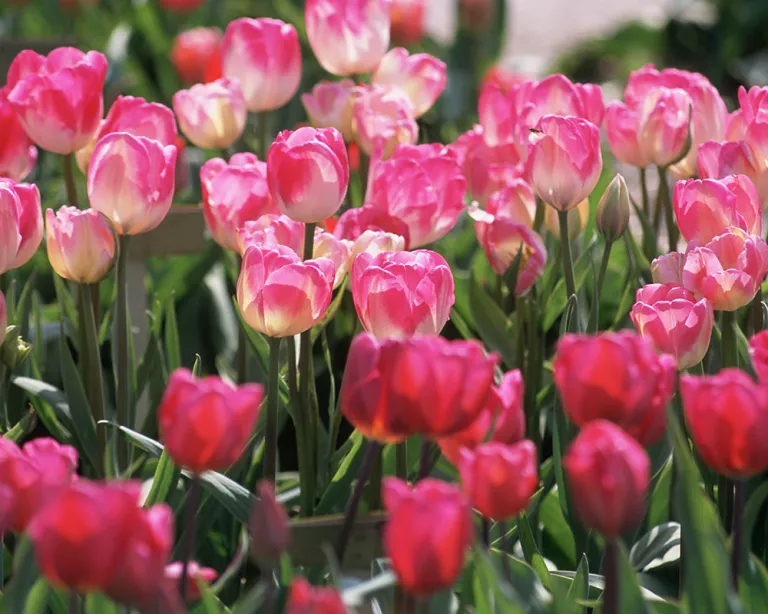
Make sure tulips have plenty of room to spread out among your perennials and herbaceous plants on a sunny border. Bulbs should be planted in five or six loose drifts at their intended planting depths. Don’t only place bulbs in rows of the same height, but mix them up, so there are no stark contrasts.
Consider mass-planting tulips for swaths of colour and the occasional tulip for landscaping ideas around trees, containers, borders or rock gardens. You can go with a more cottage-garden aesthetic by combining a wide range of tulip colours or create a striking effect by clustering tulips of the same colour.
Cut flower gardens are another excellent use for tulips. Again, it would be best to plant them in a large group, spacing the bulbs out, so they are close but not touching. The easiest way to care for these plants is to dig a trench, plant them in it, and then water the trench frequently after planting and a few times more throughout the winter.
According to Sarah Raven, “you can plant tulips in your borders singly or in small groups amid existing perennials,” but if you are planting a large number of bulbs, it may be simpler to dig out a trench or hole about 8in deep.
HOW TO STORE TULIP BULBS

You must take special care of tulip bulbs if you need to keep them for any time, even temporarily. This includes removing them from plastic or airtight containers and putting them in a cool (40 to 70oF), well-ventilated, and dry area.
HOW TO CARE FOR TULIPS

To care for your newly planted tulips, give them a thorough once-over with water. Leave them alone until new growth appears before providing them any more water. If you want your plants to thrive, you need to create an environment similar to that found in the Turkish mountains, where winters are cold, spring brings rain, and summers are scorching and dry, as Leigh Clapp explains.
In the spring, water deeply if it hasn’t rained for a few days, ensuring the soil doesn’t become waterlogged. They must be baked in the sun from June through September to prevent the bulbs from rotting. When the petals have fallen, deadhead the flowers,’ Leigh says.
When the first leaves appear above ground, you can apply a general fertilizer.
Allow the spent tulip flowerheads and leaves to wither and become yellow before picking them up. If you follow these steps, your tulip bulbs can absorb all the nutrients they need from the leaves and be ready for flourishing spring bloom.
This is how you can keep your tulips safe and healthy:
- From the time you plant, you should look for slugs and snails.
- Put some fine chicken wire over pots and in the ground to protect your tulip bulbs from mice, rabbits, deer, and squirrels. Cayenne pepper and aged cow manure are two common recommendations. Leigh Clapp suggests growing holly and prickly plants near your bulbs to keep pests away.
- Tulip fire is a fungal disease that develops in humid, warm climates and causes the leaves to turn brown and curl, giving the plant an otherwise unhealthy appearance. If it blooms at all, the flower will have a rotten, spotty appearance. Avoid planting bulbs with tiny black spots; if infected blossoms appear, remove them and kill them immediately; wait three years before planting other tulips in the same area.
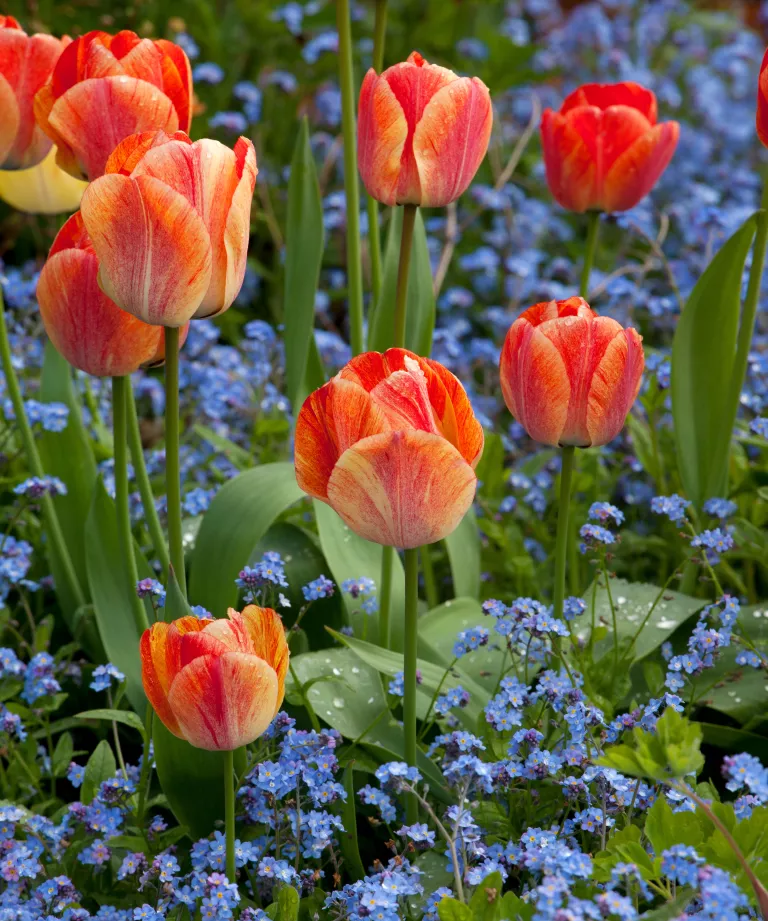
THE TYPES OF TULIPS
Tulips can be divided into early, mid, and late bloomers, single, double, fringed, lily-flowered, and parrot varieties based on their flower forms and blooming times.
New cultivars take around 20 years from the lab to the garden centre shelves, but they’re worth the wait.
Tulip varieties include the following:
- Species or botanical – smaller, delicate, very hardy, long-lived
- Parrot – flamboyant, ruffled petals
- Fringed – petals trimmed with fine fringe
- Rembrandt – modern, virus-free version of broken tulips
- Darwin hybrid – one of the most reliably perennial return bloomers
- Triumph – the largest group, mid-spring
- Lily-flowered – reflexed, pointed petals, lovely for cutting
- Single early – cup-shaped flowers
- Double early – mainly short stemmed, peony like flowers
- Single late – mainly long stemmed
- Double late – large peony-flowered, layered petals
- Virdiflora – green streaks or marking on their petals
- Kaufmanniana – compact, flowers open like stars
- Fosteriana or Emperor – large richly coloured flowers
- Greigii – ideal for a rock garden
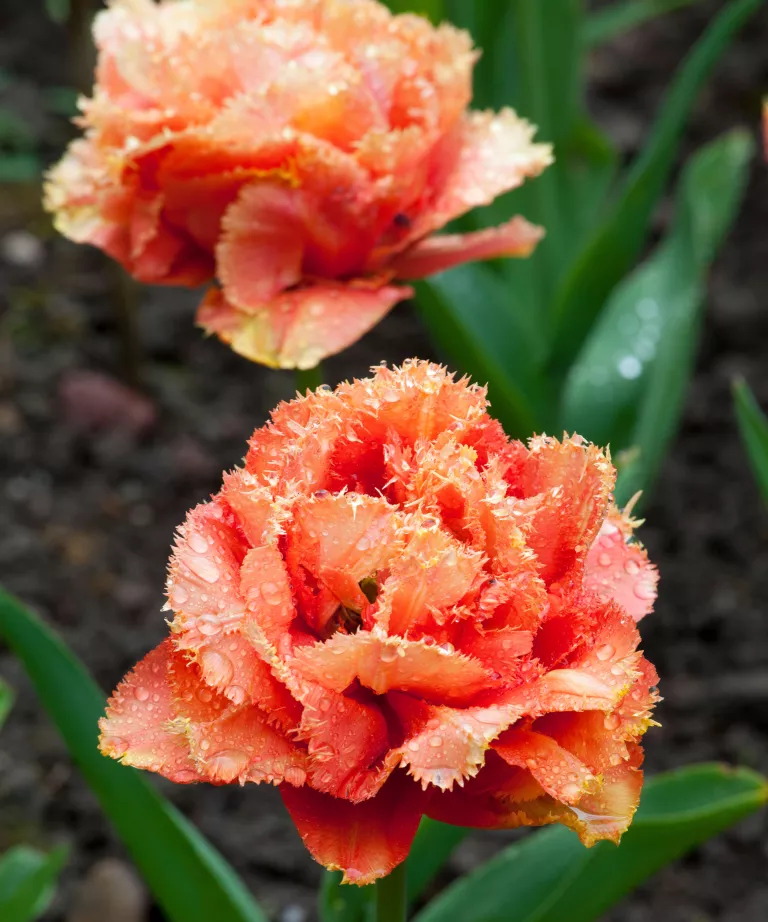
WHAT IS THE BEST MONTH TO PLANT TULIP BULBS?
You can plant tulip bulbs in September (zones 3–5), October/November (zones 6–7), and December (zones 2–3). (zones 8 to 9).
But keep an eye on the soil temperature; tulip bulbs do best in 60 degrees Fahrenheit or cooler soil, but the earth shouldn’t be frozen.
The chilly weather diminishes the risk of tulip fire, which can disfigure the blossoms. Leigh Clapp, a gardening writer, warns that if you plant these beauties too early, their leaves may shoot up and freeze during the winter.
HOW DEEP DO YOU BURY TULIP BULBS?
In most regions, tulip bulbs should be planted no deeper than 5 to 7in (or around three times the height of the tulip bulb), although 7 to 8in is recommended for areas with extreme cold.
Tulip bulbs should be planted at a deeper depth, in my opinion. Sarah Raven, a gardening expert, recommends planting tulips deeply so they don’t try to spread their seeds and so they can flower year after year.
Separate tulips by at least twice their width, or 4 to 5 inches.

CAN YOU LEAVE TULIP BULBS IN THE GROUND ALL YEAR?
Tulip bulbs can be left in the ground year-round, but they will perform and flower better if they are dug up and stored for the winter.
Once the flowers have faded and the leaves have turned yellow, you can harvest the bulbs and put them in paper bags to keep them in a cool, dry place for the winter. Please get rid of the old leaves, roots, and soil, separate any new bulbs that have formed, and make sure they dry out thoroughly, so they don’t rot.
Leave your tulips in the ground for the chance that they will bloom the following year again; this is especially true with Darwin hybrids, the Triumph series, and the lily-flowering kinds.
The easiest approach to guarantee a good display once again and to have the chance to experiment with some more beautiful colours and forms is to plant new bulbs each fall. Always use brand new bulbs when starting a container display, and remember that bulbs in pots can be planted directly in the ground, for example, in a meadow.

